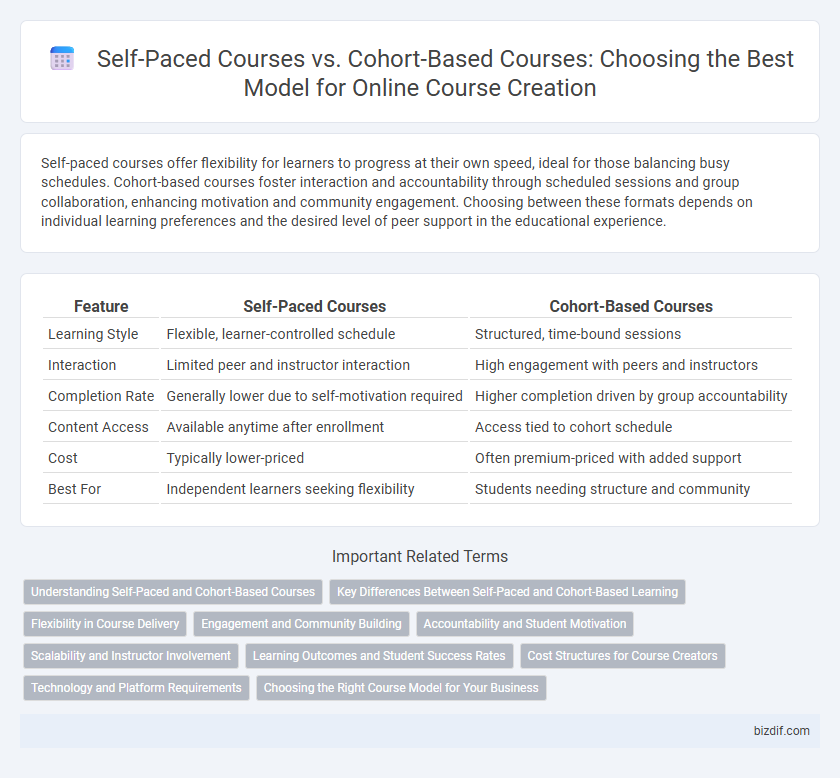Self-paced courses offer flexibility for learners to progress at their own speed, ideal for those balancing busy schedules. Cohort-based courses foster interaction and accountability through scheduled sessions and group collaboration, enhancing motivation and community engagement. Choosing between these formats depends on individual learning preferences and the desired level of peer support in the educational experience.
Table of Comparison
| Feature | Self-Paced Courses | Cohort-Based Courses |
|---|---|---|
| Learning Style | Flexible, learner-controlled schedule | Structured, time-bound sessions |
| Interaction | Limited peer and instructor interaction | High engagement with peers and instructors |
| Completion Rate | Generally lower due to self-motivation required | Higher completion driven by group accountability |
| Content Access | Available anytime after enrollment | Access tied to cohort schedule |
| Cost | Typically lower-priced | Often premium-priced with added support |
| Best For | Independent learners seeking flexibility | Students needing structure and community |
Understanding Self-Paced and Cohort-Based Courses
Self-paced courses allow learners to progress through material at their own speed, providing flexibility and accommodating diverse schedules. Cohort-based courses involve a fixed schedule where participants move through content simultaneously, fostering community engagement and real-time collaboration. Understanding the differences helps educators design effective learning experiences tailored to varying student needs and course objectives.
Key Differences Between Self-Paced and Cohort-Based Learning
Self-paced courses offer flexible scheduling, allowing learners to progress at their own speed, which suits varied learning styles and time constraints. Cohort-based courses foster interactive learning environments with fixed schedules, promoting collaboration, accountability, and peer engagement. Key differences include pacing, learner autonomy, social interaction, and completion rates, impacting course design and student outcomes.
Flexibility in Course Delivery
Self-paced courses offer unmatched flexibility by allowing learners to access content anytime and progress at their own speed, accommodating diverse schedules and learning preferences. Cohort-based courses provide structured timelines with group interactions, fostering motivation and accountability but requiring synchronized participation. Choosing between these delivery methods depends on prioritizing flexible access versus collaborative engagement in the learning experience.
Engagement and Community Building
Self-paced courses offer flexibility but often face challenges in maintaining high engagement and fostering a strong community due to isolated learning experiences. Cohort-based courses enhance participant interaction through structured timelines, promoting sustained engagement and deeper community connections. Research shows cohort models increase completion rates by up to 30% compared to self-paced formats, highlighting their effectiveness in community building.
Accountability and Student Motivation
Self-paced courses provide flexibility but often lack built-in accountability, which can lead to decreased student motivation and higher dropout rates. Cohort-based courses foster a structured learning environment with scheduled interactions, enhancing peer accountability and sustained motivation through community support. Incorporating regular checkpoints and group activities in cohort models significantly improves course completion and learner engagement.
Scalability and Instructor Involvement
Self-paced courses offer high scalability by allowing unlimited enrollment with minimal instructor intervention, making them ideal for reaching large audiences. Cohort-based courses require intensive instructor involvement for live sessions and personalized feedback, limiting scalability but enhancing learner engagement and community building. Choosing between these models depends on balancing the need for growth with the desired level of instructor interaction.
Learning Outcomes and Student Success Rates
Self-paced courses offer flexibility that allows learners to progress according to their individual schedules, often resulting in varied learning outcomes influenced by personal motivation and time management skills. Cohort-based courses foster a structured learning environment with peer interaction, collaboration, and deadlines that tend to enhance student engagement and consistent achievement of learning goals. Studies indicate cohort-based models generally yield higher student success rates due to increased accountability and support systems compared to self-paced formats.
Cost Structures for Course Creators
Self-paced courses typically require a higher upfront investment in content development but lower ongoing costs, as they can be sold repeatedly without additional instructor time. Cohort-based courses incur continuous expenses related to live sessions, community management, and instructor support, driving higher operational costs per cohort. Understanding these cost structures helps course creators optimize pricing strategies and scale their online education business effectively.
Technology and Platform Requirements
Self-paced courses demand a robust Learning Management System (LMS) with features such as on-demand video streaming, progress tracking, and asynchronous discussion forums to support flexible learner access. Cohort-based courses require integrated live streaming capabilities, real-time interaction tools like chat or breakout rooms, and automated scheduling systems to facilitate synchronized group activities and deadlines. Choosing a platform that balances these technological needs ensures an optimal experience tailored to the course format and learner engagement style.
Choosing the Right Course Model for Your Business
Self-paced courses offer flexibility, allowing learners to access content anytime, which suits businesses targeting a broad, global audience seeking convenience. Cohort-based courses foster community engagement and accountability, ideal for businesses aiming to create interactive, high-touch learning experiences that drive completion rates. Selecting the right course model depends on your business goals, learner preferences, and the level of instructor support you can provide consistently.
Self-paced courses vs Cohort-based courses Infographic

 bizdif.com
bizdif.com